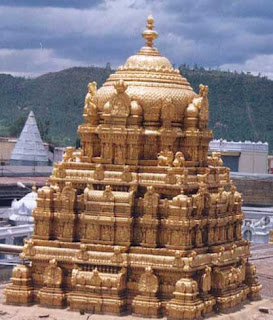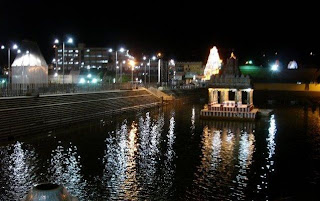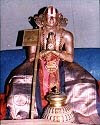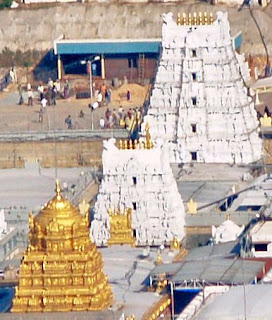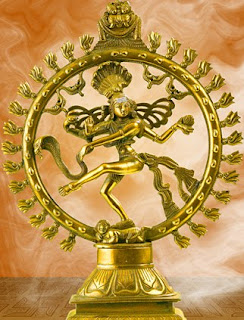Thirupathi Venkateswara:
Thirupathi Venkatachalapathi is the living God for most of the Hindus. Saivaits, Vaisnavites and all other sects of Hindus worship Thirupathy Lord Venkateswara. Accorsing to Bhagavan Ragavendra Lord Venkatachalapaty of Thirupathi is the ultimate God. A visit to the Thirupathi gives a break through in life. He is considered as Lord of Prosperity.
The temple of Sri Venkateswara has acquired unique sanctity in Indian religious lore. The Sastras, Puranas, Sthala Mahatyams and Alwar hymns unequivocally declare that, in the Kali Yuga, one can attain mukti, only by worshipping Venkata Nayaka or Sri Venkateswara.
The benefits acquired by a pilgrimage to Venkatachala are mentioned in the Rig Veda and Asthadasa Puranas. In these epics, Sri Venkateswara is described as the great bestower of boons.
There are several legends associated with the manifestation of the Lord at Tirumala
With his conch he creates the cosmic sound from which the creation has manifested.And with his disc he destroys ignorance and ego in the beings,thus liberating them. Lord Venkateswara is believed by followers to be a very merciful deity form of Vishnu, being the fulfiller of every wish made to him by the devotees.
According to Rig Vedha, the person, devoid of wealth and vision, is implored to go to the hill which burns up all evil (vikata for Venkata) and drives away all obstacles to peace and prosperity.
The ancient and sacred temple of Sri Venkateswara is located on the seventh peak, Venkatachala (Venkata Hill) of the Tirupati Hill, and lies on the southern banks of Sri Swami Pushkarini. It is in Andhra Pradesh. India.
Sri Venkatachala Mahatmya is referred to in several Puranas, of which the most important are the Varaha Purana and the Bhavishyottara Purana. The Tirupathi Tirumala hills comprising of the seven hills of Seshadri, Neeladri, Garudadri, Anjanadri, Vrushabadri, Narayanadri and Venkatadri are the abode of the Tirumala Venkateswara temple. The hill town (Tirumala) and the temple (Venkateswara Temple) are located on the Seshadri or Seshachalam hill. The temple complex comprises a smaller traditional temple building along with a number of modern queue and pilgrim lodging sites.
The varied names ascribed to the main deity are Balaji, Srinivasa, Perumal, Venkateswara and Venkatachalapathy. The goddess Sri or Lakshmi (Vishnu's consort) resides on the chest of Venkateswara, and thus he is also known by the epithet Srinivasa (the one in whom Sri resides). Goddess Lakshmi and Goddess Padmavathi reside on his either chests. The deity is considered the Kali yuga varada, that is 'the boon-granting Lord of Kali yuga' (the fourth and final age of the Hindu cycle of ages). The temple is held in particular reverence by the Vaishnava sect of southern India, known as the Sri Vaishnava.
For worshippers, the deity Venkateswara symbolises goodness. When people travel to Tirupati, they chant "Yedu Kondala Vada Venkataramana Govinda Govindaa" (in Telugu), "Yezhu Malai Vaasa Venkataramana Govinda Govindaa" (in Tamil) or "Tirupati Thimmappana Padakke Govinda" (in Kannada).
The Holy mantra chanted is Om Namo Venkateshaya. "The Venkateswara Suprabhatam", the morning recital of prayers and songs of awakening, is written by Prativadi Bhayankaram Annan of Kanchipuram.[4] Several composers composed beautiful kirtans about Lord Venkateswara, the most notable amongst them being Tyagaraja and Annamacharya. Annamacharya is a legendary devotee of Lord Venkateswara and composed songs almost exclusively about the deity.
Ramanuja Alwar got the Darshan of Lord while climbing Thirumala. He did various reforms in the temple poja procedures. Even now they are practiced in the temple.
Sri Venkatachala Mahatyam is the most accepted legend with respect to Tirumala and provides the history of the temple across the various yugas.
Lord is believed to have manifested on its own without any human endeavour (Swayambhu)
Discovery of the Venkateswara deity is described as an act of divine providence: there was a huge anthill at Tirupati, and one day a local farmer heard a voice from the heavens asking him to feed the ants. By chance the local king heard the voice and began supplying milk for the ants himself. His compassion resulted in the liquid uncovering the magnificent deity form of Venkateswara hidden beneath the anthill.
Thondaiman, ruler of the ancient Thondaimandalam (present day Kanchipuram) (capital: Kanchipuram, just south of modern day Chennai), is believed to have first built the temple after visualising Lord Vishnu in his dream. He built the Gopuram and the Prakhara, and arranged for regular prayers to be conducted in the temple. Later on the Chola dynasty vastly improved the temple and gave rich endowments.
To date, you will find the various Tamil Grantha script within the Temple prakara walls. The Sangam literature of Tamil such as that of Silapadikaram and Satanar Manimekalai, dated between 500BC and 300AD, mentions Thiruvengadam (now named Tirupati) by the appellation "Nediyon Kunram" as the northernmost frontier of the Tamil kingdoms . In fact, a fairly detailed description of the deity is given in lines 41 to 51 of book 11 of the Silapadikaram
Many devotees have their head tonsured as an offer. The daily amount of hair collected is over a ton. The hair thus gathered is sold by the temple organization a few times a year by public auction to international buyers for use as hair extensions and in cosmetics, bringing over $6 mln to the temple's treasury.
It is the richest Hindu temple. Devotees offer a portion of their earnings to the Thirupathi Venkateswara. They believe what ever the amount given to the Lord returns back to them in greater magnitude.
Laddu is the world famous prasadam given at Tirumala Temple.[13] Many other delicious prasadams are also available including curd rice, pulihora(tamarind rice in telugu), vada and Chakkera-pongali (sweet pongal in telugu). Free meals are given daily to the pilgrims, and on Thursdays, the Tirupavadai seva occurs, where food items are kept for naivedyam to Lord Srinivasa.
Suprabath is a popular prayer song on Lord Venkateswara of Thirupathi. The other popular songs on the Lord are Sri Venkatesa Stotram and Sri Venkatesa Prapatti.
Download Suprabath
Thanks to Thirumala.org


